How to automate software license optimization
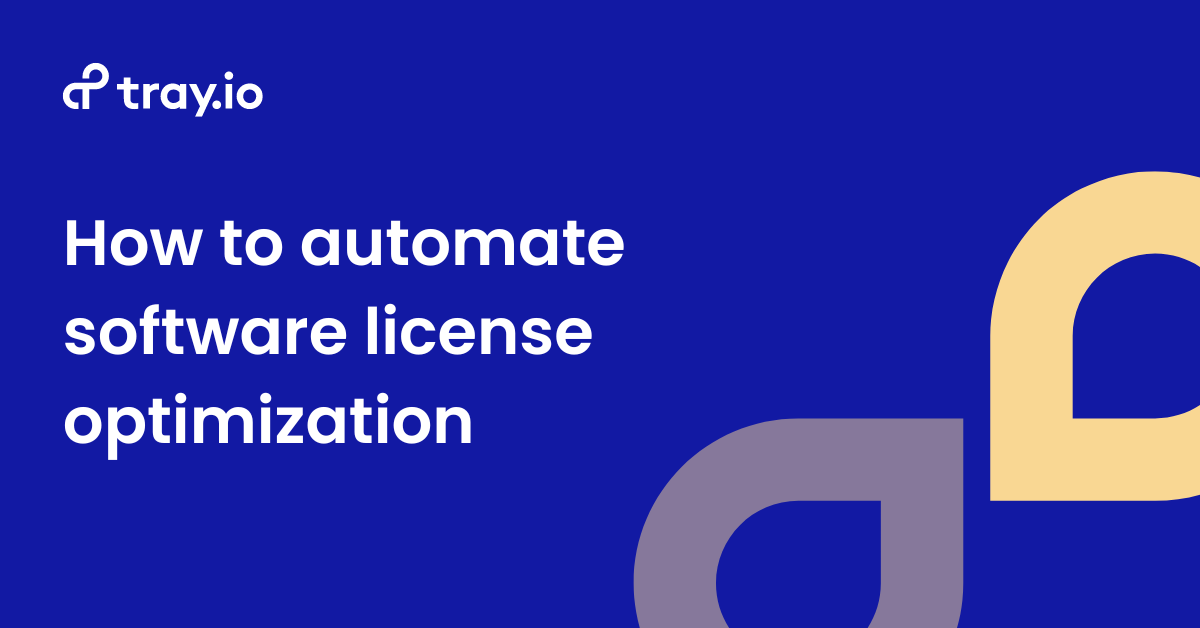

Christina Kokoros
Every year, companies waste thousands of dollars on unused software licenses. Learn how we use Tray to automate software license optimization.
Let’s face it – money doesn’t grow on trees, and yet, a good chunk of what we spend on IT might as well be thrown out the window. A recent survey found that 10% of enterprise IT budgets are wasted on software licenses that aren’t being used. For a mid-sized company pulling in $50 million in annual revenue and investing an average of 4.1% in IT, that’s $205,000 wasted on underused software. That’s not just a drop in the bucket. It’s a leak that needs plugging. Here at Tray, we too found we were wasting resources and revenue on managing software licenses. So leveraging our own Tray Universal Automation Cloud, we created our very own software license optimization workflow.
What exactly is software license optimization?
Software license optimization is the process of systematically managing and allocating software licenses so that your organization only purchases what is necessary and makes full use of its software investments. This involves analyzing how software is used across the company, ensuring compliance with licensing agreements, and avoiding both over- and under-provisioning of software licenses.
Put simply, software license optimization is all about getting the right number of licenses for the right tools at the right time. It’s about more than just saving a few bucks. It’s about making sure that the software that makes up your stack is working as hard as your team is. No excess. No shortfall. Just the perfect fit.
Why is software license optimization important?
According to Gartner, IT leaders may be pumping the brakes on new investments and pushing spend down the road. In other words, CIOs are laser-focused on squeezing value out of every dollar and doubling down on cost efficiency. That’s why software license optimization is crucial for businesses to control costs, maintain compliance with software vendors’ licensing agreements, and ensure that employees have the tools they need to be productive. It’s a balancing act that requires precision and understanding of both the software landscape and the workforce’s needs.
At Tray, we recognize the need to focus on initiatives that yield immediate operational efficiencies. Software license optimization aligns perfectly with the approach, offering a way to control costs effectively and bolster our commitment to strategic, agile IT management.
Software license optimization challenges
There’s no overnight solution for getting your organization’s software licenses in order. While there are software license management (SLM) platforms that can help, there’s no one-size-fits-all solution. Automation platforms like Tray are flexible enough to build your own software license optimization solution. But whichever road you choose, there will be challenges, including:
Complex licensing agreements: Deciphering the terms and conditions of various software agreements can be daunting.
Diverse user needs: Catering to the specific needs of different departments and roles within a company requires getting teams and resources in sync.
Dynamic software landscape: Keeping up with the rapidly changing software requirements of the organization can stall progress.
Cost management: Balancing the need for tools with the imperative to control IT spending requires extensive planning.
Benefits of software license optimization
The good news is that however you plan to tackle software license management, the risk of doing nothing greatly outweighs the cost. Whether building a solution in-house or bringing on additional SLM software, you’ll see ROI relatively quickly as overspending and underuse become quickly identified and remedied. Benefits include:
Cost savings: By only paying for the software that is actually used, companies can significantly reduce wasted IT spend.
Compliance: Ensure that organizations are not at risk of licensing breaches, which can lead to hefty fines.
Resource efficiency: Helps IT teams allocate their time and company resources more effectively.
Strategic alignment: Aligns software spend with business needs, ensuring that investments are driving value.
The old way vs. the Tray way
Without an automated process in place, here’s traditionally how IT teams manage licenses:
Manually pull a report for each software application
Write an email blast to all users (and hope they check the email)
Manually check who has responded and who hasn’t
Manually follow up with those who haven’t responded
Manually remove users licenses
Repeat for all SaaS applications
And here’s how our automated process at Tray works:
Reports run automatically and flag users likely not using a tool anymore
Message is drafted via AI based on previous messages
Loop in a Trayer to send the message to all flagged users via Slack
Users respond directly from Slack with the click of a button
Automatically send a follow-up to anyone who hasn’t responded with the click of a button
Confirm the list and automatically de-provision their licenses
So to break it down, here’s the challenge we face, the solution we implemented, and the results that we saw:
Challenge: Paying for unused or underutilized software licenses.
Solution: Reach out to all users with customized messaging to verify license needs across the organization.
Results:
Optimize license cost (~10% of IT budget saved in 2023)
Two vendors deprecated
Understand Tool Utilization Overall ahead of renewals
Keep reading to see specifically how we set up our software license management workflow.
How we built a software license optimization solution on Tray
At Tray, we faced the challenge of managing a sprawling software environment with 152 active vendors, only a fraction of which had provisioning/de-provisioning through Okta. That left 100+ applications for our IT and Operations team to manually manage. This led to inefficiencies, potential compliance risks, and unnecessary costs. Here’s how we fixed it:
Software license optimization walkthrough
To tackle this, we implemented an automated workflow that leverages the Google Sheets connector and Slack to mass message a list of users (using their email to pull their Slack ID) with a one-question poll asking if they still need access to the application we are looking to clean up.
To see this walkthrough in action, check out this builder workshop.
Here’s the initial messaging workflow:
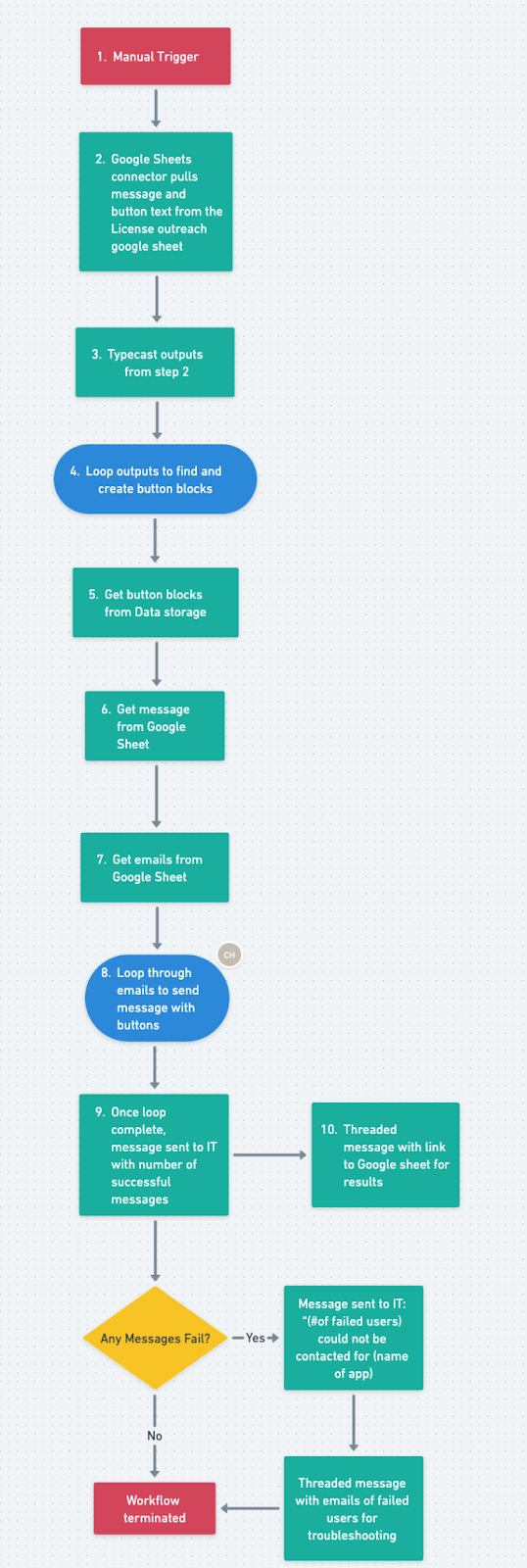
Let’s take a closer look at what is actually happening in these steps.
Manual trigger: Everything starts with a manual trigger. That means a real person gives the green light for the automation to begin its work.
Gathering data: Next, our Google Sheets connector springs into action, fetching all the details for our outreach.
Typecast: We then use our typecast operation to form that data into a more appropriate output.
Buttons: We loop through the data to create the button that will appear in our Slack messages – the ones users will click to cast their vote on the software they use. Button blocks are then summoned from data storage, ready to be attached to the messages.
Distribution: We pull the message content from the Google Sheet and, using user emails, form a list of who will receive the messages. Messages are then sent out.
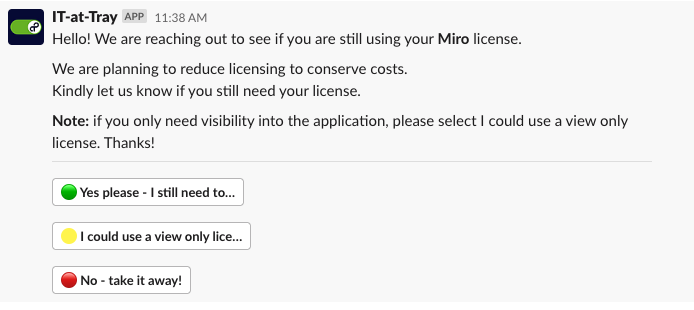
6. Data collection: Responses are automatically logged into a Google sheet. Users are instantly informed when their response is recorded.
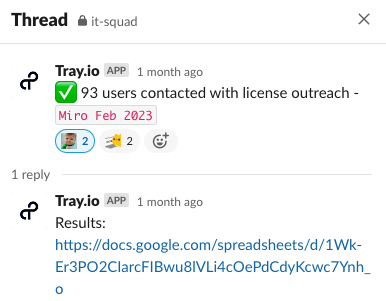
Here’s a look at the response workflow:
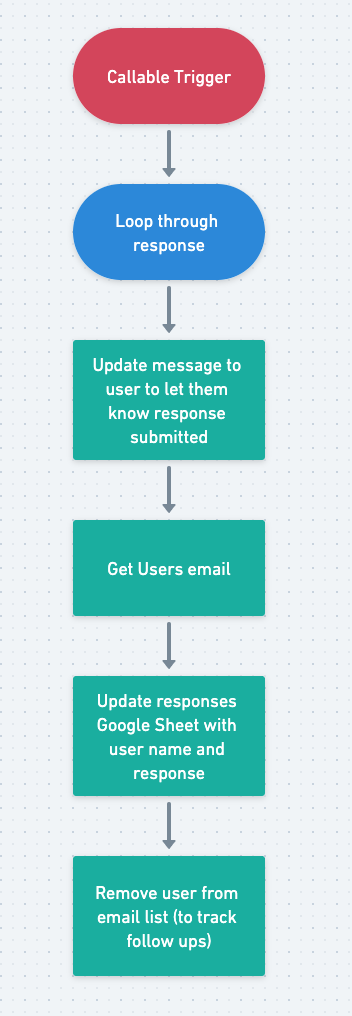
7. Decision-making: With the responses recorded, IT can now easily decide how to proceed with managing the referenced software licenses.
8. Process refinement: The workflow removes respondents from the list to streamline future audits.

Customizing this solution for your use case
It's important to note that the workflow we've laid out is a robust template, designed to fit a broad range of needs with its messaging and specific connections. However, this is just one piece of the puzzle when it comes to our comprehensive software license management workflow.
The initial data gathering and reporting, as well as the final steps of license removal, are more bespoke operations tailored to our unique infrastructure. At Tray.io, for instance, we employ a mix of Okta, DataDog, and Push Security for these tasks, while other organizations might lean on Active Directory, LogicMonitor, etc.
So, while our template provides a solid foundation with its universal messaging framework, be aware that integrating the full suite into your system may require additional customization to communicate with the specific tools and platforms your organization uses. This flexibility is the beauty of the Tray platform – it's designed to adapt and scale according to your specific IT ecosystem.
Going further by infusing AI
Imagine a system that not only automates tasks but also learns from them. There is immense potential for infusing AI into IT processes and the Tray Universal Automation Cloud lets us easily integrate AI into any workflow. With Merlin AI, our intelligence layer, along with our OpenAI connector, Anthropic connector, and templates that can help you leverage AI for classification and extraction, the possibilities are endless.
Messaging and outreach
One area we're harnessing AI is in messaging. Based on past successful communications, AI can draft messages for license outreach, tailoring them to get the most effective response. And it's not about removing the human touch—quite the opposite. AI helps us bridge the gap between technical processes and the human elements, ensuring our internal users receive personalized, relevant messages.
Automating the mundane to focus on the strategic
But why stop there? AI can take on the repetitive, transactional work that bogs down our IT teams. Think about automated license checks or drafting support tickets; these are tasks AI can handle with ease. This frees up our human experts to focus on strategy and innovation—the real drivers of business growth.
Continuous innovation is key
Software license optimization is not a one-and-done process. It requires continuous attention and adjustment. By leveraging our automation platform, we were able to transform the challenge of software license management into an opportunity for efficiency and strategic resource allocation, ensuring that our software environment is both cost-effective and perfectly tailored to our business needs.
To learn more about how Tray can transform IT Ops processes like software license management, sign up for a tailored demo.